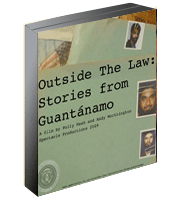“Close Guantánamo,” Says Prison’s First Commander, Adds That It “Should Never Have Been Opened”
 In an important op-ed for the Detroit Free Press, Maj. Gen. Mike Lehnert of the Marines, the first commander of Guantánamo, has called for the closure of the prison. Maj. Gen. Lehnert built the open air cages of Camp X-Ray, the “war on terror” prison’s first incarnation, in just four days prior to the arrival of the first prisoners on January 11, 2002.
In an important op-ed for the Detroit Free Press, Maj. Gen. Mike Lehnert of the Marines, the first commander of Guantánamo, has called for the closure of the prison. Maj. Gen. Lehnert built the open air cages of Camp X-Ray, the “war on terror” prison’s first incarnation, in just four days prior to the arrival of the first prisoners on January 11, 2002.
As I explained in my book The Guantánamo Files, Lehnert initially bought into the hyperbole and propaganda about the prisoners, stating, soon after the prison opened, “These represent the worst elements of al-Qaeda and the Taliban. We asked for the worst guys first.” However, he soon changed his mind. In early February 2002, he provided an important insight into how, contrary to what senior Bush administration officials were saying in public, the uncomfortable truth was they they had no idea who most of the prisoners were. “A large number claim to be Taliban, a smaller number we have been able to confirm as al-Qaeda, and a rather large number in the middle we have not been able to determine their status,” he said, adding, “Many of the detainees are not forthcoming. Many have been interviewed as many as four times, each time providing a different name and different information.”
Unfortunately, the Bush administration responded not by acknowledging that it had, with a handful of exceptions, bought and rounded up civilians and low-level Taliban conscripts, but by aggressively interrogating the men over many years and, in many cases, introducing a torture program involving prolonged sleep deprivation, isolation, humiliation, the use of loud music and noise, and the exploitation of phobias. This produced copious amounts of information, as was revealed when WikiLeaks released classified military files relating to the prisoners in April 2011, but much of it was fundamentally unreliable. Read the rest of this entry »
WikiLeaks: The Unknown Prisoners of Guantánamo (Part Three of Five)
Freelance investigative journalist Andy Worthington continues his 70-part, million-word series telling, for the first time, the stories of 776 of the 779 prisoners held at Guantánamo since the prison opened on January 11, 2002. Adding information released by WikiLeaks in April 2011 to the existing documentation about the prisoners, much of which was already covered in Andy’s book The Guantánamo Files and in the archive of articles on his website, the project will be completed in time for the 10th anniversary of the prison’s opening on January 11, 2012.
This is Part 3 of the 70-part series.
One of the great publicity coups in WikiLeaks’ recent release of classified military documents relating to the majority of the 779 prisoners held at Guantánamo, as I explained in the first part of this five-part series, was to shine a light on the stories of the first 201 prisoners to be freed from the prison between its opening, in January 2002, and September 2004, when 35 prisoners were repatriated to Pakistan, and 11 were repatriated to Afghanistan.
A handful of these 46 prisoners were cleared for release as a result of the Combatant Status Review Tribunals, a one-sided process, which ran from August 2004 to March 2005 and was designed to rubber-stamp the prisoners’ prior designation as “enemy combatants,” who could continue to be held indefinitely. Information about the 558 prisoners who passed through the CSRT process (PDF) was first made publicly available in 2006, but no records have ever been publicly released by the US government which provide any information whatsoever about the 201 released, or approved for release before the CSRTs began, except for a prisoner list released in May 2006 (PDF), which contains the names, nationalities, and, where known, dates of birth and places of birth for 759 prisoners (all but the 20 who arrived at Guantánamo between September 2006 and March 2008).
In the years since the documents relating to the CSRTs were released (and information relating to their annual follow-ups, the Administrative Review Boards, or ARBs), I attempted to track down the stories of these 201 men, and managed, largely through successful research that led to relevant media reports, interviews and reports compiled by NGOs, to discover information about 114 of these prisoners, but nothing at all was known about 87 others (except for their names, and, in some cases, their date of birth and place of birth). With the release of the WikiLeaks files, all but three of these 87 stories have emerged for the very first time, and in this series of articles, I am transcribing and condensing these stories, and providing them with some necessary context. The first 17 stories were in Part One, the second 17 were in Part Two, and the third 17 are below. Also see Part Four and Part Five. Read the rest of this entry »
WikiLeaks: The Unknown Prisoners of Guantánamo (Part Two of Five)
Freelance investigative journalist Andy Worthington continues his 70-part, million-word series telling, for the first time, the stories of 776 of the 779 prisoners held at Guantánamo since the prison opened on January 11, 2002. Adding information released by WikiLeaks in April 2011 to the existing documentation about the prisoners, much of which was already covered in Andy’s book The Guantánamo Files and in the archive of articles on his website, the project will be completed in time for the 10th anniversary of the prison’s opening on January 11, 2012.
This is Part 2 of the 70-part series.
As I explained last week in the first part of this five-part series, one of the great publicity coups in WikiLeaks’ recent release of classified military documents relating to the majority of the 779 prisoners held at Guantánamo was to shine a light on the stories of the first 201 prisoners to be freed from the prison between its opening, in January 2002, and September 2004, when 35 prisoners were repatriated to Pakistan, and 11 were repatriated to Afghanistan.
As I also explained, a handful of these 46 prisoners were cleared for release as a result of the Combatant Status Review Tribunals, a one-sided process, which ran from August 2004 to March 2005 and was designed to rubber-stamp the prisoners’ prior designation as “enemy combatants,” who could continue to be held indefinitely. Information about the 558 prisoners who passed through the CSRT process (PDF) was first made publicly available in 2006, but no records have ever been publicly released by the US government which provide any information whatsoever about the 201 released, or approved for release before the CSRTs began, except for a prisoner list released in May 2006 (PDF), which contains the names, nationalities, and, where known, dates of birth and places of birth for 759 prisoners (all but the 20 who arrived at Guantánamo between September 2006 and March 2008).
In the years since the documents relating to the CSRTs were released (and information relating to their annual follow-ups, the Administrative Review Boards, or ARBs), I attempted to track down the stories of these 201 men, and managed, largely through successful research that led to relevant media reports, interviews and reports compiled by NGOs, to discover information about 114 of these prisoners, but nothing at all was known about 87 others (except for their names, and, in some cases, their date of birth and place of birth). With the release of the WikiLeaks files, all but three of these 87 stories have emerged for the very first time, and in this series of articles, I will run through these stories.The first 17 stories were in Part One, and the second 17 are below. Also see Part Three, Part Four and Part Five. Read the rest of this entry »
WikiLeaks: The Unknown Prisoners of Guantánamo (Part One of Five)
Please support my work!
Freelance investigative journalist Andy Worthington begins a 70-part, million-word series telling, for the first time, the stories of 776 of the 779 prisoners held at Guantánamo since the prison opened on January 11, 2002. Adding information released by Wikileaks in April 2011 to the existing documentation about the prisoners, much of which was already covered in Andy’s book The Guantánamo Files and in the archive of articles on his website, the project will be completed in time for the 10th anniversary of the prison’s opening on January 11, 2012.
This is Part 1 of the 70-part series. It was updated on September 21, 2011.
In WikiLeaks’ recent release of classified military documents relating to the majority of the 779 prisoners held at Guantánamo, one of the great publicity coups was shining a light on the stories of the first 201 prisoners to be freed from the prison, between May 2002, when a severely schizophrenic Afghan prisoner, Abdul Razak, was returned to his home country, and September 2004, when 35 prisoners were repatriated to Pakistan, and 11 were repatriated to Afghanistan.
A handful of these 46 prisoners were cleared for release as a result of the Combatant Status Review Tribunals, which began on August 13, 2004 and concluded on March 29, 2005. These, as Lt. Col. Stephen Abraham, a veteran of US intelligence who worked on the tribunals has explained, were essentially part of a one-sided process designed to create the illusion that the prisoners’ cases were being objectively examined to determine whether, on capture, they had been correctly designated as “enemy combatants,” who could continue to be held indefinitely.
558 prisoners passed through the CSRT process, and records released by the Pentagon in 2006, as the result of a successful lawsuit filed by media groups, provided details of all these men’s cases — the government’s supposed evidence against them, and transcripts of the CSRTs (and their annual follow-ups, the Administrative Review Boards), or, at least, transcripts of the tribunals and review boards in which the prisoners had deigned to take part, after many boycotted them, correctly perceiving that they were essentially a sham. Read the rest of this entry »














 Who's still at Guantánamo?
Who's still at Guantánamo?
